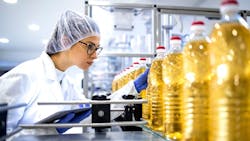How poor lubrication practices contribute to contamination risks in food manufacturing
Key takeaways
- The 10 ppm lubricant limit for food and beverage processing equipment is a failure threshold, not a preventive measure.
- Seal integrity and hygienic design are the real defenses against food contamination.
- Focus on engineering solutions like condition monitoring as meaningful control points for real-world operations.
Lubricants are widely used in food and beverage processing equipment under the premise that their accidental contact with food is safe up to a maximum of 10 parts per million (ppm). While this threshold appears to offer regulatory assurance, a closer inspection reveals that the 10 ppm standard is not a meaningful control point in real-world operations.
In fact, the focus on ppm distracts from what truly ensures food safety: mechanical integrity, seal performance, and hygienic equipment design. There is flawed logic behind ppm-based risk control and advocates for a preventive engineering mindset.
Understanding H1 food-grade lubricants and their role in contamination risk management
H1 lubricants are specifically formulated for incidental contact with food. To be certified, they must be composed of ingredients listed on the FDA's Generally Recognized As Safe (GRAS) list and approved by the National Sanitation Foundation (NSF). However, H1 lubricants are not edible. Their inclusion in food products, even accidentally, must be limited to no more than 10 ppm, as they are minimally toxic at low concentrations.
What 10 ppm really means for food safety in manufacturing environments
Let’s break down what 10 ppm actually looks like in practice:
- 1 gallon = 3.785 liters
- 55 gallons = 208.175 liters
- Assuming a water-like density, 55 gallons = ~208,175 grams of liquid
- 10 ppm = 10 parts per million = (10 / 1,000,000) × 208,175 grams = 2.08175 grams
This is roughly half a teaspoon of lubricant dispersed into an entire 55-gallon drum. Can you measure that on a single tortilla? In a batch of cereal? On a piece of sliced meat? No. You can't.
Why relying on ppm thresholds fails to ensure contamination control in processing plants
The 10 ppm allowance was never designed as a method of controlling contamination. It is a threshold to determine when action (like scraping product) is required. It assumes an already failed system.
You cannot measure 10 ppm of lubricant on most food surfaces with current quality control technologies. It’s impractical, if not impossible, to detect such trace contamination in most processing lines. Yet we continue to see manufacturers and auditors obsess over ppm as if it were a real-time monitorable parameter. It's not.
Engineering-based strategies to prevent lubricant contamination in food manufacturing
The only real way to prevent contamination is to prevent lubricant escape altogether. Instead of chasing ppm ghosts, food safety professionals and engineers should focus on:
- Seal Integrity: Selecting and maintaining seals that withstand washdowns, CIP cycles, and thermal cycling.
- Lubricant Retention: Using proper application methods, purge setups, and minimal-volume techniques to reduce lubricant migration.
- Hygienic Design: Designing equipment that isolates lubrication points from food zones.
- Condition Monitoring: Using tools like ultrasound, pressure differential, and vibration analysis to monitor lubricant migration and seal failure.
- Safe Tracers in Oil: How about an additive that is in the lubricant that could be measured but safe?
Shifting from ppm allowances to performance-driven contamination prevention
The 10 ppm rule is not a protective barrier; it’s a concession to failure. The real work of contamination prevention lies in proactive engineering: making sure lubricant never contacts food at all. That means higher standards for seals, smarter system design, and a commitment to true hygienic reliability.
Let’s stop pretending we can manage half a teaspoon of grease across an entire processing line and start building systems where that scenario never happens in the first place. Just say'n.
About the Author
Michael Holloway
Michael Holloway
Michael D. Holloway is President of 5th Order Industry which provides training, failure analysis, and designed experiments. He has 40 years' experience in industry starting with research and product development for Olin Chemical and WR Grace, Rohm & Haas, GE Plastics, and reliability engineering and analysis for NCH, ALS, and SGS. He is a subject matter expert in Tribology, oil and failure analysis, reliability engineering, and designed experiments for science and engineering. He holds 16 professional certifications, a patent, a MS Polymer Engineering, BS Chemistry, BA Philosophy, authored 12 books, contributed to several others, cited in over 1000 manuscripts and several hundred master’s theses and doctoral dissertations.
